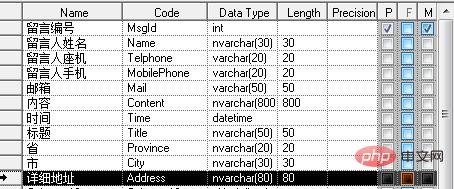秒懂数据库三范式
本篇文章给大家带来的内容是介绍数据库设计的三大范式,让大家了解理解三大范式数据库的三大范式。有一定的参考价值,有需要的朋友可以参考一下,希望对你们有所帮助。
数据库设计范式
什么是范式:
简言之就是,数据库设计对数据的存储性能,还有开发人员对数据的操作都有莫大的关系。所以建立科学的,规范的的数据库是需要满足一些规范的来优化数据数据存储方式。在关系型数据库中这些规范就可以称为范式。【相关视频教程推荐:mysql教程】
三大范式是什么:
第一范式:当关系模式R的所有属性都不能在分解为更基本的数据单位时,称R是满足第一范式的,简记为1NF。满足第一范式是关系模式规范化的最低要求,否则,将有很多基本操作在这样的关系模式中实现不了。
第二范式:如果关系模式R满足第一范式,并且R得所有非主属性都完全依赖于R的每一个候选关键属性,称R满足第二范式,简记为2NF。
第三范式:设R是一个满足第一范式条件的关系模式,X是R的任意属性集,如果X非传递依赖于R的任意一个候选关键字,称R满足第三范式,简记为3NF.
注:关系实质上是一张二维表,其中每一行是一个元组,每一列是一个属性
理解三大范式
第一范式
1、每一列属性都是不可再分的属性值,确保每一列的原子性
2、两列的属性相近或相似或一样,尽量合并属性一样的列,确保不产生冗余数据。


如果需求知道那个省那个市并按其分类,那么显然第一个表格是不容易满足需求的,也不符合第一范式。


显然第一个表结构不但不能满足足够多物品的要求,还会在物品少时产生冗余。也是不符合第一范式的。
第二范式
每一行的数据只能与其中一列相关,即一行数据只做一件事。只要数据列中出现数据重复,就要把表拆分开来。

一个人同时订几个房间,就会出来一个订单号多条数据,这样子联系人都是重复的,就会造成数据冗余。我们应该把他拆开来。


这样便实现啦一条数据做一件事,不掺杂复杂的关系逻辑。同时对表数据的更新维护也更易操作。
第三范式
数据不能存在传递关系,即没个属性都跟主键有直接关系而不是间接关系。像:a-->b-->c 属性之间含有这样的关系,是不符合第三范式的。
比如Student表(学号,姓名,年龄,性别,所在院校,院校地址,院校电话)
这样一个表结构,就存在上述关系。 学号--> 所在院校 --> (院校地址,院校电话)
这样的表结构,我们应该拆开来,如下。
(学号,姓名,年龄,性别,所在院校)--(所在院校,院校地址,院校电话)
最后:
三大范式只是一般设计数据库的基本理念,可以建立冗余较小、结构合理的数据库。如果有特殊情况,当然要特殊对待,数据库设计最重要的是看需求跟性能,需求>性能>表结构。所以不能一味的去追求范式建立数据库。
总结:以上就是本篇文章所介绍的秒懂数据库三范式的全部内容,希望能对大家的学习有所帮助。更多请关注php中文网其它相关文章!

Hot AI Tools

Undresser.AI Undress
AI-powered app for creating realistic nude photos

AI Clothes Remover
Online AI tool for removing clothes from photos.

Undress AI Tool
Undress images for free

Clothoff.io
AI clothes remover

AI Hentai Generator
Generate AI Hentai for free.

Hot Article

Hot Tools

Notepad++7.3.1
Easy-to-use and free code editor

SublimeText3 Chinese version
Chinese version, very easy to use

Zend Studio 13.0.1
Powerful PHP integrated development environment

Dreamweaver CS6
Visual web development tools

SublimeText3 Mac version
God-level code editing software (SublimeText3)

Hot Topics
 1378
1378
 52
52
 MySQL: Simple Concepts for Easy Learning
Apr 10, 2025 am 09:29 AM
MySQL: Simple Concepts for Easy Learning
Apr 10, 2025 am 09:29 AM
MySQL is an open source relational database management system. 1) Create database and tables: Use the CREATEDATABASE and CREATETABLE commands. 2) Basic operations: INSERT, UPDATE, DELETE and SELECT. 3) Advanced operations: JOIN, subquery and transaction processing. 4) Debugging skills: Check syntax, data type and permissions. 5) Optimization suggestions: Use indexes, avoid SELECT* and use transactions.
 How to open phpmyadmin
Apr 10, 2025 pm 10:51 PM
How to open phpmyadmin
Apr 10, 2025 pm 10:51 PM
You can open phpMyAdmin through the following steps: 1. Log in to the website control panel; 2. Find and click the phpMyAdmin icon; 3. Enter MySQL credentials; 4. Click "Login".
 How to create navicat premium
Apr 09, 2025 am 07:09 AM
How to create navicat premium
Apr 09, 2025 am 07:09 AM
Create a database using Navicat Premium: Connect to the database server and enter the connection parameters. Right-click on the server and select Create Database. Enter the name of the new database and the specified character set and collation. Connect to the new database and create the table in the Object Browser. Right-click on the table and select Insert Data to insert the data.
 How to create a new connection to mysql in navicat
Apr 09, 2025 am 07:21 AM
How to create a new connection to mysql in navicat
Apr 09, 2025 am 07:21 AM
You can create a new MySQL connection in Navicat by following the steps: Open the application and select New Connection (Ctrl N). Select "MySQL" as the connection type. Enter the hostname/IP address, port, username, and password. (Optional) Configure advanced options. Save the connection and enter the connection name.
 MySQL and SQL: Essential Skills for Developers
Apr 10, 2025 am 09:30 AM
MySQL and SQL: Essential Skills for Developers
Apr 10, 2025 am 09:30 AM
MySQL and SQL are essential skills for developers. 1.MySQL is an open source relational database management system, and SQL is the standard language used to manage and operate databases. 2.MySQL supports multiple storage engines through efficient data storage and retrieval functions, and SQL completes complex data operations through simple statements. 3. Examples of usage include basic queries and advanced queries, such as filtering and sorting by condition. 4. Common errors include syntax errors and performance issues, which can be optimized by checking SQL statements and using EXPLAIN commands. 5. Performance optimization techniques include using indexes, avoiding full table scanning, optimizing JOIN operations and improving code readability.
 How to recover data after SQL deletes rows
Apr 09, 2025 pm 12:21 PM
How to recover data after SQL deletes rows
Apr 09, 2025 pm 12:21 PM
Recovering deleted rows directly from the database is usually impossible unless there is a backup or transaction rollback mechanism. Key point: Transaction rollback: Execute ROLLBACK before the transaction is committed to recover data. Backup: Regular backup of the database can be used to quickly restore data. Database snapshot: You can create a read-only copy of the database and restore the data after the data is deleted accidentally. Use DELETE statement with caution: Check the conditions carefully to avoid accidentally deleting data. Use the WHERE clause: explicitly specify the data to be deleted. Use the test environment: Test before performing a DELETE operation.
 How to use single threaded redis
Apr 10, 2025 pm 07:12 PM
How to use single threaded redis
Apr 10, 2025 pm 07:12 PM
Redis uses a single threaded architecture to provide high performance, simplicity, and consistency. It utilizes I/O multiplexing, event loops, non-blocking I/O, and shared memory to improve concurrency, but with limitations of concurrency limitations, single point of failure, and unsuitable for write-intensive workloads.
 MySQL: An Introduction to the World's Most Popular Database
Apr 12, 2025 am 12:18 AM
MySQL: An Introduction to the World's Most Popular Database
Apr 12, 2025 am 12:18 AM
MySQL is an open source relational database management system, mainly used to store and retrieve data quickly and reliably. Its working principle includes client requests, query resolution, execution of queries and return results. Examples of usage include creating tables, inserting and querying data, and advanced features such as JOIN operations. Common errors involve SQL syntax, data types, and permissions, and optimization suggestions include the use of indexes, optimized queries, and partitioning of tables.




